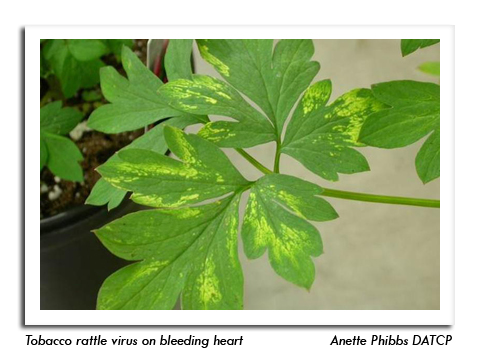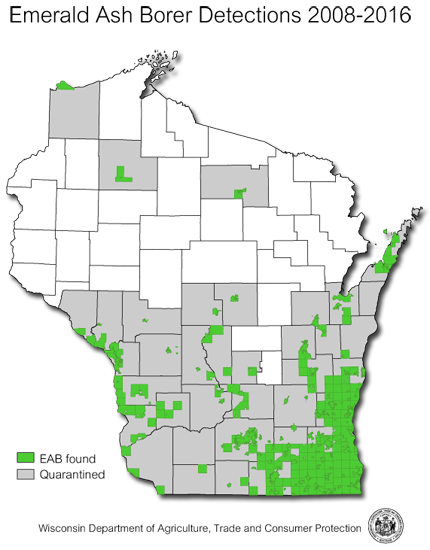
 |
|
|
Nursery & Forest
Volume 61 Number 19 Date 12/08/2016 VIRUSES IN ORNAMENTALS - Laboratory testing of ornamentals from Wisconsin greenhouses, nurseries and retailers found potyviruses were the most prevalent plant viruses this season. Nursery inspectors submitted 253 samples to the Plant Industry Lab for diagnosis. Sixty-three percent tested positive for at least one plant virus. Following potyviruses with 87 positives, other common viruses were tobacco rattle virus with 40 positives, clematis chlorotic mottle virus with 14 positives, and hosta virus X with nine positives. Greenhouse producers and nurseries cooperated with inspectors by removing all virus-infected plant material from sale. SUDDEN OAK DEATH - One hundred and eight plant samples collected from 51 nurseries were tested for SOD at the Plant Industry Lab; all were negative for this regulated disease. Sudden oak death has not been found in Wisconsin. BOXWOOD BLIGHT - A major concern to the nursery industry, this fungal disease affecting boxwoods was not detected in any of the five boxwood samples submitted for testing in 2016. ROOT AND COLLAR ROT - White root rot, also known as Dermatophora root rot, was identified as the cause of mortality in white spruce trees at a Chippewa County nursery. In addition, Swiss pines from Washington County exhibiting root collar rot were infected with Phytophthora kelmania, a pathogen first associated with declining fir Christmas trees in Grant and Manitowoc counties in 2010. Pine is a new host of this pathogen in Wisconsin. -- Anette Phibbs, DATCP Plant Pathologist NURSERY INSPECTION - Nursery Program personnel inspected 331 nursery grower fields this year, representing a large percentage of the production of the 624 licensed nursery growers in the state. Staff also conducted inspections at 527 sites selected from Wisconsin's 1,142 licensed nursery dealers. The top 10 insect and plant diseases found in 2016 were, by total number of detections: viruses, leafspots, powdery mildew, Japanese beetle, non-viable stock, mites, aphids, rusts, apple scab, and chlorosis/nutrient deficiencies. Inspectors issued 151 Plant Health Certificates for the shipment and export of nursery stock. LECANIUM SCALE - Populations were extremely heavy on a wide variety of hardwood trees across the northern regions of the state in June and July. Severe branch mortality, crown dieback and honeydew accumulation on branches and leaves were reported in Brown, Door, Kewaunee, Langlade, Lincoln, Marinette, Oconto, Oneida, Shawano, St. Croix and Vilas counties. Another species of soft scale, magnolia scale, was also abundant on magnolia trees and shrubs for the second year in a row. IMPATIENS DOWNY MILDEW - A single Impatiens plant from a Kenosha retailer tested positive for IDM in June and was promptly removed from sale. INVASIVE SPECIES RULE - DATCP inspectors documented 90 violations at 130 nursery locations this season, a sharp increase from 43 locations in 2015, 13 in 2014, and 19 in 2013. The most frequently intercepted invasives were aquatic forget-me-not, Bishops goutweed, black alder, burning bush, Japanese barberry, ribbon grass and Siberian peashrub, all of which are prohibited or restricted in Wisconsin under the Chapter NR 40 Invasive Species Rule. SYSTEMS APPROACH TO NURSERY CERTIFICATION (SANC) - McKay Nursery Company in Waterloo, Wisconsin became the nation's first SANC-certified nursery in mid-August. Pennsylvania's Conrad-Pyle nursery was second, and six more pilot-program nurseries should all become certified by early 2017. The SANC Program is a voluntary risk-based alternative to traditional nursery stock certification that enables the export of plants based on specific, rigorous and documented production practices, rather than conventional inspection methods: http://sanc.nationalplantboard.org. -- Liz Meils, DATCP Nursery Inspector THOUSAND CANKERS DISEASE (TCD) - Twenty-five funnel traps paired with black walnut branch cuttings were deployed in Chippewa, Crawford, Dane, Grant, Iowa, Jefferson, La Crosse, Richland, Rock, Sauk, Trempealeau, Vernon and Walworth counties to detect TCD. Survey locations included wood disposal sites and sawmills receiving black walnut logs from TCD-infested states. No walnut twig beetles were captured in survey traps. Processing of walnut branch cuttings for beetle galleries and signs of the TCD fungus is still underway. EMERALD ASH BORER - Detections of EAB surged from 39 in 2015 to 92 this year, bringing the total number of municipal detections since 2008 to 268. Most of the finds were near generally-infested areas in the southeast where EAB is now well established. Other infestations were identified in the central and western parts of the state and along the Mississippi and Wisconsin Rivers where EAB populations are still isolated. The cooperative EAB trapping survey consisting of 818 traps in 37 counties resulted in the capture of beetles on four traps, and the first detection of an adult EAB in Sawyer County. EAB was confirmed in five more counties this year: Juneau, Portage, Manitowoc, Sawyer and Wood. The state EAB quarantine expanded in 2016 and is currently comprised of 42 counties in the southern half of Wisconsin, as well as Douglas, Oneida and Sawyer counties in the far north. EXOTIC BEETLE SURVEY - Seven species of exotic bark- and wood-boring beetles were surveyed for at 10 eastern Wisconsin port locations in Brown, Door, Kenosha, Kewaunee, Manitowoc, Marinette, Milwaukee, Ozaukee, Racine and Sheboygan counties. The survey involved one baited trap per target species at each site, 70 traps total. Processing of trap samples was incomplete as of December 8, but results are negative so far. -- Renee Pinski, DATCP Forest Entomologist GYPSY MOTH - Moth counts decreased significantly in 2016. The state trapping program recorded a total capture of 86,462 male moths in 11,383 traps, a major decline from previous years. Program coordinators attribute the lower moth numbers to a wet spring with intervals of cold weather, as well as to the fact fewer traps were placed this year. The season's highest catches were in Bayfield (11,441 moths), Juneau (8,551 moths), and Sauk (7,749 moths) counties. No surveyed county reported zero moths. The DATCP Slow the Spread Program treated a total of 165,948 acres at 86 sites in 19 counties from May 12-July 18. Btk was applied to 26,822 acres and mating disruption flakes covered 175,842 acres. The DNR Suppression Program also treated two sites totaling 102 acres in Rock and Sauk counties with Btk. There were no eradication sites or NPV treatments this year, and no new counties were added to the 50-county Wisconsin Gypsy Moth Quarantine. -- Nolan Stracke, Public Information Officer 





|
|
|